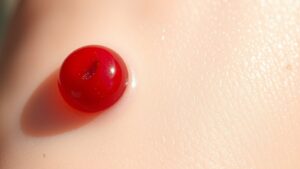Envision tiny, bright red spots popping up on your skin, like cherries on a sundae. These cherry angiomas can spark intrigue and a hint of concern. You may question what causes them and whether they’re a sign of something more serious. Comprehending their origins and how to treat them can ease your mind. Stick around to uncover the details of these common skin growths and find out what you can do should you wish to change their appearance.
What Is a Cherry Angioma?
Cherry angiomas could sound a bit fancy, but they’re really just small, harmless spots that pop up on your skin.
These common skin growths are made up of small blood vessels and typically appear as bright red lesions, mainly on your torso, arms, and legs.
Commonly appearing as bright red lesions, cherry angiomas are small skin growths composed of tiny blood vessels found on the torso, arms, and legs.
While the aging process plays a big role in their development, about 50% of adults over 30 and 75% of those over 75 have them.
The best part? These benign skin lesions are usually asymptomatic, meaning they don’t cause discomfort or pain.
However, should they bleed from scratching or injury, you may consider a treatment for cherry angiomas, although it’s often only for cosmetic reasons.
They’re a normal part of life!
Causes of Cherry Angiomas
While the specific reasons behind the development of cherry angiomas couldn’t be crystal clear, a few key factors seem to play a significant role.
Aging is one of the biggest culprits, with over 75% of people over 75 developing these spots. You could also notice that genetic predisposition plays a part, as cherry angiomas often run in families.
Hormonal changes, especially during pregnancy, can contribute to the eruption of these growths. Certain chemical exposures, like topical nitrogen mustard, have been linked, though evidence is limited.
Additionally, eruptive cherry angiomas could arise from health conditions, such as herpesvirus-8, or the use of certain medications, particularly immunosuppressants.
Comprehending these causes can help you feel a bit more in control.
Symptoms and Appearance
Cherry angiomas can look a bit different from one another, but you’ll usually find they’re small, round, and bright red.
They often show up on your torso, arms, and shoulders, sometimes clustering together.
While they can be slightly raised and come in shades of blue or purple, they typically don’t cause any discomfort unless you accidentally scratch one.
Color Variations in Angiomas
Upon uncovering a cherry angioma, you could observe these small, lively spots can differ greatly in hue.
Most commonly, cherry angiomas appear bright red due to the dilated blood vessels underneath the skin. However, you could also notice them in blue or purple shades, showcasing fascinating color variations.
These benign skin growths can vary in size from 1 mm to 5 mm, and their color intensity can shift regardless of your skin tone. Sometimes they come with a smooth texture and could even have a pale halo, enhancing their reddish appearance.
Even though they’re usually harmless, it’s essential to take care while touching them, as scratching could cause them to bleed, altering their unique colors temporarily.
Size and Shape Characteristics
These lively skin marks, known as cherry angiomas, come in various sizes and shapes, making them unique little additions to our skin terrain. They typically range from 1 mm to 5 mm in diameter and can appear as small, flat, bright red spots or slightly raised bumps. The shapes can be circular or oval, and there’s often a cluster of them together. Their color can vary from light red to deep dark red, while some might even look blue or purple. They usually have a smooth texture, and although they’re benign, scratching them can lead to bleeding. Here’s a quick overview of cherry angioma characteristics:
| Characteristic | Description |
|---|---|
| Size | 1 mm to 5 mm |
| Shape | Circular or oval |
| Color | Light red to dark red, blue, or purple |
| Symptoms | Painless, smooth texture, could bleed when scratched |
Common Locations on Body
While cherry angiomas can pop up in various sizes and shapes on your skin, they also have their favorite hangout spots. You’re likely to find these benign skin lesions on your torso, arms, legs, and shoulders, where they really stand out.
Their bright cherry-red appearance could catch your eye, but they can also appear blue or purple, especially as they age. Typically, they start as small, flat spots before slightly raising over time, keeping a round or oval shape.
It’s not uncommon for cherry angiomas to cluster together. Even though they usually don’t cause discomfort, keep in mind they can bleed when scratched.
Diagnosis of Cherry Angiomas
Upon noticing a small red bump on your skin, getting it checked out is a smart move.
A healthcare provider usually relies on a quick visual exam to diagnose a cherry angioma, but they’ll also consider other possibilities to guarantee accurate identification.
Should something seem off, like changes in size or color, they may suggest a biopsy for further confirmation.
Visual Skin Examination
A quick glance at your skin can reveal a lot, especially at the time it comes to identifying cherry angiomas. These bright cherry-red skin lesions usually catch the eye of healthcare providers during a visual examination.
Their smooth texture and size ranging from 1 mm to 5 mm help in quick diagnosis. Sometimes, healthcare professionals might use dermoscopy, a tool for magnified visualization, to evaluate them more closely.
Should you notice any changes in size, shape, or color of a cherry angioma, or should it start to bleed, it’s wise to seek a medical consultation. This step can help determine whether further evaluation or a potential biopsy is necessary for accurate diagnosis.
Keep in mind, staying proactive about your skin health is essential!
Differential Diagnosis Process
Comprehending the differential diagnosis process for cherry angiomas is essential, especially since you could encounter other skin conditions that look similar.
Your healthcare provider will typically start with a visual examination, noting the size, shape, and color of the angiomas. It’s important to differentiate cherry angiomas from conditions like melanoma, which might require careful assessment should any symptoms arise, such as bleeding or itching.
Even benign lesions like pyogenic granulomas may mimic them. Should there be uncertainty, a biopsy can confirm the diagnosis and rule out malignancy.
Monitoring any changes over time is fundamental, as these could signal the need for a medical evaluation. Keep in mind, identifying these characteristics promptly can lead to proper treatment and peace of mind.
Biopsy for Confirmation
Should you be managing cherry angiomas, it’s good to know that confirming their diagnosis usually doesn’t involve a complicated process. Generally, a healthcare provider conducts a visual examination, identifying these benign growths quickly. However, should you notice abnormal changes in size, shape, or color, a biopsy could be recommended to rule out serious conditions like melanoma.
Here’s how the process typically unfolds:
| Step | Description |
|---|---|
| Visual Examination | Initial assessment by a dermatologist |
| Dermoscopy | Detailed inspection to find specific patterns |
| Biopsy | Tissue sample taken for further analysis |
| Result Interpretation | Confirming diagnosis or identifying issues |
Always consult your dermatologist for personalized advice should you be concerned about your cherry angiomas.
Treatment Options for Cherry Angiomas
In circumstances where you’re feeling self-conscious about cherry angiomas, you’re not the only one—many individuals share your concerns about their appearance.
Should you decide to remove cherry angiomas, you’ve got a few common removal methods at your disposal. Options like electrodesiccation use an electric current to burn the angioma, while cryosurgery employs liquid nitrogen to freeze it away.
When considering cherry angioma removal, popular methods include electrodesiccation and cryosurgery for effective results.
Laser treatment is another effective choice, targeting blood vessels in the angioma with focused light—just know you may need several sessions for the best results.
It’s crucial to keep in mind that while these treatments are generally safe and effective, cherry angiomas can recur after treatment, though they remain benign skin lesions, posing no serious risk.
When to Seek Medical Attention
Questioning whether it’s time to consult a doctor about your cherry angiomas? It’s essential to seek medical attention should you notice any changes in size, shape, or color of these growths, as they could indicate something more serious, like skin cancer.
Should your cherry angioma bleed or doesn’t stop bleeding after a minor injury, don’t hesitate to reach out to a healthcare provider. A sudden outbreak of multiple cherry angiomas can be an indicator of fundamental health conditions, so contacting a dermatologist is wise.
Regular check-ups help in monitoring skin growths too. Finally, should the appearance of your cherry angiomas cause discomfort or emotional distress, talking to a medical professional can provide the reassurance you need.





